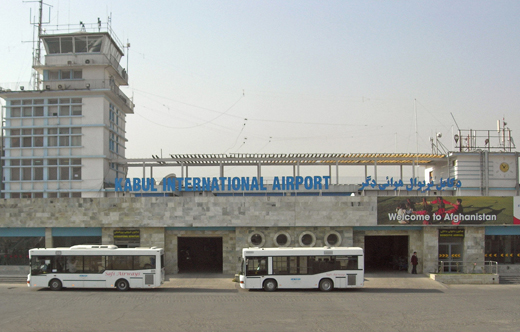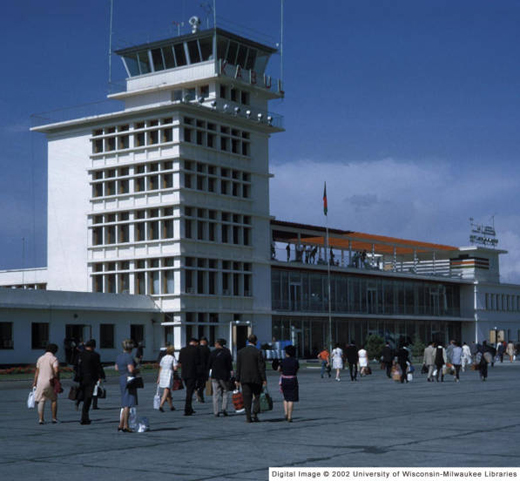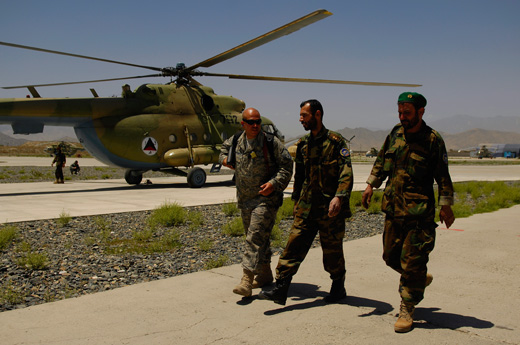 |
|
Kabul International Airport
دکابل نړیوال هوایی ډګر
میدان بین المللی کابل |
 |
| IATA: KBL – ICAO: OAKB |
| Summary |
| Airport type |
Public/Military |
| Owner |
Ministry of Transportation and Civil Aviation |
| Operator |
Hellenic Air Force
(as a part of ISAF) |
| Location |
Kabul |
| Elevation AMSL |
5,877 ft / 1,789 m |
| Coordinates |
34°33′56″N 69°12′39″E / 34.56556°N 69.21083°E / 34.56556; 69.21083 |
| Runways |
| Direction |
Length |
Surface |
| ft |
m |
| 11/29 |
11,482 |
3,500 |
Paved |
Kabul International Airport (IATA: KBL, ICAO: OAKB),(Pashto: دکابل نړیوال هوایی ډګر), (Persian: میدان بین المللی کابل ), also known as Khwaja Rawash Airport, is located 16 kilometers (9 miles) from the city center of Kabul, Afghanistan.
Kabul International Airport was built in the early 1960s at a time when Afghanistan was becoming modernized. During the 10 year Soviet war in Afghanistan from 1979 to 1989, the airport was in full control of the Red Army. Following the Soviet withdrawal it remained in control of the Soviet-backed Afghan military that switched to private militia and other regimes until late 2001 when the United States and allies invaded Afghanistan.
At first, Kabul Airport was only for the United States armed forces and the International Security Assistance Force (ISAF), a NATO-led peacekeeping force. After the removal of UN sanctions, in early 2002, it was finally allowed to be used for civilian airlines. The US military and ISAF (with the Romanian Air Force a lead contributor in 2005) run the military section of the airport and provide security there. The Afghan National Police and Afghan National Army are in control of security inside and around the airport. History and construction
 | |
Kabul Airport in 1969 |
Kabul Airport was originally built in the early 1960s by Soviet Union engineers. Around this time in history, Afghanistan was becoming a modernized nation and catching up with the rest of the nations in the world. Many western tourists from places such as America, Europe, India, and else where started flocking to the country via Kabul Airport. This era tragically ended in late 1970s when the country began facing political turmoil.
The airport was used by the Soviet Union's Red Army during the Soviet War in Afghanistan, from 1979 to 1989, . It was also used by the military forces of former President of Afghanistan, Mohammad Najibullah, until 1992. It fell in the hands of local mujahideen forces for several years and then took over by the Taliban until late 2001 when they fled the city after US invasion of Afghanistan. Due to international sanctions under the Taliban government, the airport was closed in late 1990s, with very limited international flights.
Following the US-NATO invasion of Afghanistan, after the September 11, 2001 attacks in the United States of America, Kabul International Airport was bombed and destroyed about a month later by the United States armed forces. All the planes on the ground were also hit and destroyed by the pilots of the United States Air Force. The airport has never seen any development until very recent when US and NATO forces took control of the premises.
In 2006, the government of Afghanistan accepted an assistance package from the government of Japan to rebuild Kabul International Airport. The plan included a modern 35 million US dollar terminal for international passengers. Afghanistan's President, Hamid Karzai, and other high profile figures attended the inauguation ceremony. The new terminal was officially opened to international flights on 2 June 2009. The existing terminal has been refurbished and is currently being used for domestic flights.
Movements are expected to reach 100,000 by 2011, which is when Ariana Afghan Airlines and Kam Air will receive their new airplanes. Also, the Afghan Air Force will receive 45 new aircraft by then.
Military use
 | |
Kabul Airport is the hub for the Afghan Air Force, which also provides security to the airport. |
The North Side Cantonment - Kabul International Airport facility was completed and turned over to the United States armed forces in September / October 2008. It will house the command facilities for the Afghan National Army Air Corps, and includes housing, administrative, operations, maintenance and recreation facilities. The project includes two new hangar complexes, new taxiway and ramps. It is the headquarters and main base of the Air Corps. The first hangar facility was turned over to the Afghan National Air Corps in January 2008. The second hangar was completed in 2008.
Airlines and destinations
| Airlines |
Destinations |
| Ariana Afghan Airlines |
Al Ain, Ankara, Delhi, Dubai, Dushanbe, Frankfurt, Herat, Istanbul-Atatürk, Jeddah, Kandahar, Kuwait, Mashhad, Mazar-i-Sharif, Moscow-Sheremetyevo, Riyadh, Tehran-Imam Khomeini, Ürümqi |
| Flydubai |
Dubai |
| Indian Airlines |
Delhi |
| Iran Aseman Airlines |
Mashhad |
| Kam Air |
Almaty, Delhi, Dubai, Dushanbe, Herat, Islamabad, Kandahar, Mashhad, Mazar-i-Sharif, Peshawar, Tarin Kot, Ürümqi, Vienna |
| Pakistan International Airlines |
Islamabad, Peshawar |
| Pamir Airways |
Chagcharan, Delhi, Dubai, Faizabad, Herat, Jeddah, Kandahar, Kunduz, Lashkargah, Mazar-i-Sharif, Riyadh |
| Safi Airways |
Delhi, Doha, Dubai, Frankfurt, Kuwait |
Cargo
| Airlines |
Destinations |
| Emirates SkyCargo |
Dubai |
| Etihad Crystal Cargo |
Abu Dhabi, Sharjah |
GalleryFacilities
The airport has two terminal buildings, the modern for international flights and the Soviet built one for domestic flights. Several hangers along the runway are for military aircraft. There are no hangers for civilian (or transient) aircraft.
The airport has 7 helicopter pad for mostly military traffic.
Fire fighting equipment is present, replacing Soviet era tenders with donations from Britain and UAE.
Transportation
Transportation to and from the airport are buses, taxi and private cars. The airport is connected to Kabul from a 4 lane highway, but it shares the roadway with pedestrian traffic.
Accidents and incidents
Civilian
- On 2 January 1962, Iran Air Flight 123, a Douglas C-47 on a cargo flight, crashed whilst attempting to take-off from Kabul. During the take-off roll the captain noticed a malfunction in the number 1 engine followed by the aircraft veering to the left of the runway. To avoid a crash, the captain pulled the aircraft up into the air, but whilst attempting to turn the aircraft away from the airport, a wing struck the ground followed by a crash. Both crew members survived.
- On 21 September 1984, an Ariana Afghan Airlines McDonnell Douglas DC-10-30 was hit by explosive bullets while on approach to Kabul Airport. All passengers and crew survived the incident.
- On 12 June 1990, an Aeroflot Ilyushin Il-76 was struck by a missile whilst flying at 22,500 ft (6,858 m) causing two engines to shut down. The aircraft made a forced landing in Kabul with no flaps on an unpaved runway. All 10 crew survived.
- On 29 May 1992, an Ariana Afghan Airlines Tupolev Tu-154 was struck by a missile while landing in Kabul. The nose of the aircraft was damaged but the flight landed safely. All passengers and crew survived.
- On 19 March 1998, an Ariana Afghan Airlines Boeing 727-200 crashed into the 3,000 ft (914 m) Sharki Baratayi mountain whilst descending into Kabul. All 10 crew and 35 passengers on board died.
- On 16 September 2004, an Antonov An-24 operated by Kam Air, slewed off the runway while landing at Kabul slightly injuring some of the 27 passengers aboard, but the plane was not damaged.
- On 3 February 2005, Kam Air Flight 904, a Boeing 737-200 operated by Phoenix Aviation, vanished from radar screens on approach to Kabul in poor weather, sparking a massive ANA search operation for the 96 passengers and eight crew. The wreckage of the aircraft was found two days later in the mountains east of Kabul, but all 104 people on board had been killed.
Military
- On 11 March 1985, a Soviet Air Force Antonov An-30 was on an aerial photography flight in the Kabul area south of the Panjshir Valley. Upon returning to the airport, the aircraft was struck by a Strela missile. The captain tried to make an emergency landing at Bagram but was too high. A fire ignited by the missile strike then reached the aileron controls causing the pilots to lose control; three of the five crew members evacuated the aircraft safely, but the other two crew members died.
- On 29 November 1986, a Soviet Air Force Antonov An-26 was hit by a stinger missile whilst climbing out of Kabul. The aircraft was carrying several tons of S-24 rockets and 400 kg of explosives to Jalalabad in Afghanistan. All seven crew members perished.
- On 21 October 1987, a Soviet Air Force Antonov An-12BK collided with a Mil Mi-24 helicopter whilst taking off in poor visibility. The flight was heading for the capital city of Uzbekistan, Tashkent; 18 of the 19 passengers and crew died.
- On 21 December 1987, a Soviet Air Force Antonov An-26 was hit by a stinger missile whilst circling to a safe altitude shortly after take-off. The number one engine was hit causing the fuel tank to get punctured. Smoke entered the cabin so all six crew members parachuted out; the captain jumped out too close to the ground to open his parachute, he died apon impacting the ground.
- On 24 June 1988, a Soviet Air Force Antonov An-26 was hit by bullets fired from Mujahideen rebels. The aircraft crashed in Kabul killing one of the six crew members on board.
- On 28 August 1992, a Soviet Air Force Ilyushin Il-76MD was hit by a renegade Mujahideen rocket whilst boarding Russian embassy staff.
- On 5 August 2008, a United Arab Emirates Air Force Lockheed C-130H Hercules overran the runway upon landing in Kabul causing a fire in the forward section of the aircraft. The aircraft was carrying aid to Afghanistan. All crew members survived.
Non-aircraft related
- On 8 September 2009, a bomb blast occurred near the airport's entrance around 8:22am local time.
The above content comes from Wikipedia and is published under free licenses – click here to read more.
| General Info
|
| Country |
Afghanistan
|
| ICAO ID |
OAKB
|
| Time |
UTC+4:30
|
| Latitude |
34.565853
34° 33' 57.07" N
|
| Longitude |
69.212328
069° 12' 44.38" E
|
| Elevation |
5877 feet
1791 meters
|
| Type |
Joint (Civil and Military)
|
| Magnetic Variation |
002° E (05/06)
|
| Operating Agency |
MILITARY - CIVIL JOINT USE AIRPORT
|
| Operating Hours |
SUNRISE TO SUNSET (SR-SS)
|
| International Clearance Status |
Airport of Entry
|
| Communications
|
| TWR |
129.4
134.5
284.275
|
| GND |
120.3
|
| APP/DEP |
131.6
360.6
|
| Runways
|
| ID |
Dimensions |
Surface |
PCN |
ILS
|
| 11/29 |
11483 x 164 feet
3500 x 50 meters |
ASPHALT |
059RBWT |
YES
|
| Navaids
|
| Type |
ID |
Name |
Channel |
Freq |
Distance From Field |
Bearing From Navaid
|
| TACAN |
OKB |
KABUL |
065X |
- |
At Field |
-
|
| VOR-DME |
KBL |
KABUL |
057X |
112 |
4.1 NM |
284.9
|
| Supplies/Equipment
|
| Fuel |
Jet A1, without icing nhibitor.
|
| Remarks
|
| CAUTION |
Possible wind shear on final app both rwys. Unexploded ordnance adj to all acft movement areas. FOD haz. Extv UAV flt in lcl area. New mil apn LTD wingtip passing on twy J.
|
| FUEL |
A1
|
| MISC |
No flt pln svc avbl, file return flt pln prior to dep. Wx avbl.
|
| OPR HOURS |
Opr SR-SS.
|
| RSTD |
Day VFR ops only. PPR and slot time rqr, ref FLIP AP/3. Twy Z btn twy F and E for mil ops only.
|
The content above was published at Airports-Worldwide.com in 2010.
We don't guarantee the information is fresh and accurate. The data may be wrong or outdated.
For more up-to-date information please refer to other sources.
|
 |



